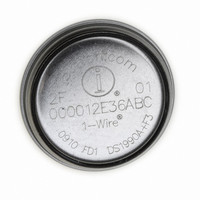DS1923-F5# Maxim Integrated Products, DS1923-F5# Datasheet - Page 21

DS1923-F5#
Manufacturer Part Number
DS1923-F5#
Description
IBUTTON TEMP/HUMIDITY LOGGER F5
Manufacturer
Maxim Integrated Products
Series
iButton®r
Datasheet
1.DS1923-F5.pdf
(55 pages)
Specifications of DS1923-F5#
Rohs Information
IButton RoHS Compliance Plan
Memory Size
512B
Memory Type
NVSRAM (Non-Volatile SRAM)
Lead Free Status / RoHS Status
Lead free by exemption / RoHS compliant by exemption
Available stocks
Company
Part Number
Manufacturer
Quantity
Price
Bit 0: Enable Oscillator (EOSC). This bit controls the
crystal oscillator of the RTC. When set to logic 1, the
oscillator starts. When written to logic 0, the oscillator
stops and the device is in a low-power data-retention
mode. This bit must be 1 for normal operation. A
Forced Conversion or Start Mission command automati-
cally starts the RTC by changing the EOSC bit to
logic 1.
The DS1923 is set up for its operation by writing appro-
priate data to its special function registers, which are
located in the two register pages. The settings in the
Mission Control register determine whether temperature
and/or humidity is logged, which format (8 or 16 bits)
applies, and whether old data can be overwritten by
new data once the data-log memory is full. An addition-
al control bit can be set to tell the DS1923 to wait with
logging data until a temperature alarm is encountered.
Bit 5: Start Mission Upon Temperature Alarm
(SUTA). This bit specifies whether a mission begins
immediately (includes delayed start) or if a temperature
alarm is required to start the mission. If this bit is 1, the
device performs an 8-bit temperature conversion at the
selected sample rate and begins with data logging only
if an alarming temperature (high alarm or low alarm)
was found. The first logged temperature is when the
alarm occurred. However, the Mission Samples
Counter does not increment. The start upon tempera-
ture alarm function is only available if temperature log-
ging is enabled (ETL = 1).
Bit 4: Rollover Control (RO). This bit controls whether,
during a mission, the data-log memory is overwritten
with new data or whether data logging is stopped once
the data-log memory is full. Setting this bit to 1 enables
the rollover and data logging continues at the begin-
Note: During a mission, there is only read access to this register. Bits 6 and 7 have no function. They always read 1 and cannot be written to 0.
ADDRESS
0213h
Hygrochron Temperature/Humidity Logger
BIT 7
______________________________________________________________________________________
1
BIT 6
iButton with 8KB Data-Log Memory
1
Mission Control
SUTA
BIT 5
BIT 4
RO
ning, overwriting previously collected data. If this bit is
0, the logging and conversions stop once the data-log
memory is full. However, the RTC continues to run and
the MIP bit remains set until the Stop Mission command
is performed.
Bit 3: Humidity Logging Format Selection (HLFS).
This bit specifies the format used to store humidity
readings in the data-log memory. If this bit is 0, the
data is stored in 8-bit format. If this bit is 1, the 16-bit
format is used (higher resolution). With 16-bit format,
the most significant byte is stored at the lower address.
Bit 2: Temperature Logging Format Selection
(TLFS). This bit specifies the format used to store tem-
perature readings in the data-log memory. If this bit is
0, the data is stored in 8-bit format. If this bit is 1, the
16-bit format is used (higher resolution). With 16-bit for-
mat, the most significant byte is stored at the lower
address.
Bit 1: Enable Humidity Logging (EHL). To set up the
DS1923 for a humidity-logging mission, this bit must be
set to logic 1. If temperature and humidity logging are
enabled, the recorded humidity values begin at
address 2000h (TLFS = HLFS) or 1A00h (TLFS = 0;
HLFS = 1) or 2400h (TLFS = 1; HLFS = 0). If only
humidity logging is enabled, the recorded values are
stored starting at address 1000h. Since humidity data
has little scientific value without knowing the tempera-
ture, typically both humidity and temperature logging
are enabled (i.e., ETL and EHL are set to 1).
Bit 0: Enable Temperature Logging (ETL). To set up
the device for a temperature-logging mission, this bit
must be set to logic 1. To successfully start a mission,
ETL or EHL must be 1. If temperature logging is
enabled, the recorded temperature values are always
stored starting at address 1000h.
HLFS
BIT 3
Mission Control Register Bitmap
TLFS
BIT 2
BIT 1
EHL
BIT 0
ETL
21












